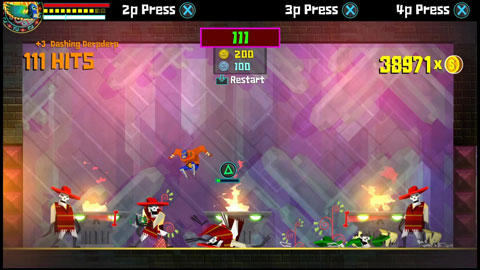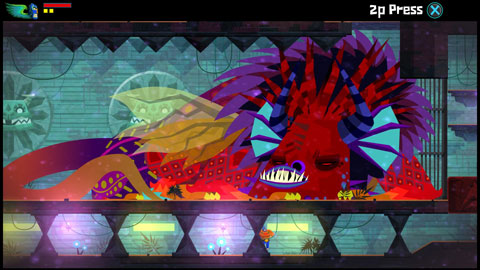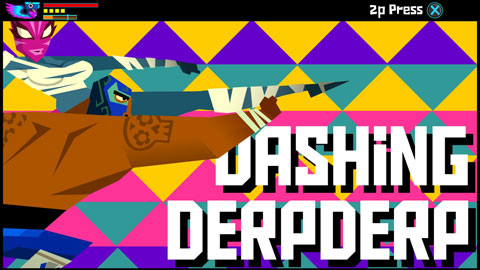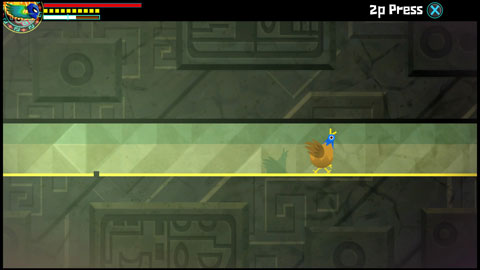
Last year, in 2014, one game came out that exploded in popularity and won over the hearts and minds of many. That game was called Shovel Knight, and many reviewers gave it high scores and declared it among their list of favourite games of all time. And I will tell you something, I love this game too. It’s a 2D side-scroller hack and slash that pays homage to games like Ducktales, Mega Man, and so many others. It has great controls, a memorable soundtrack, one of the best stories in video gaming, and had a great amount of replayability. There is so much to love and gush over.
But here’s the thing. Over one year before that, a different game came out a similar way and gave me a much similar reaction. And the overall reception among others was mostly a glance. To be honest, I wasn’t sure why, but today, it gets the recognition it deserves. This game was called Guacamelee. It was developed by a Toronto independent company called Drinkbox Studios. Guacamelee was a Metroidvania style platformer beat-em-up that had influences from games like Super Metroid, and I’ve made it public knowledge that my favourite game of all time is Super Metroid. Guacamelee also has some amazing visuals, incredible music and gameplay that I came back to over and over again. And dare I say it, I loved this game just as much as today’s reviewers who loved Shovel Knight. In fact, and this is no joke, Guacamelee became among my list of my favourite games of all time. And yet somehow, when the game came out, I didn’t know how to put that love and desire into words for a review at the time. And now, I need to rectify this, right now. Submitted for the approval of the Review A Great Game Day 2015 society, this is an open love letter for Guacamelee!
Guacamelee came out in April of 2013 for the Playstation 3 and the Playstation Vita, with some cross play, and later it was ported onto Steam and other Windows programs. There were many downloadable content with Playstation 3 game, including new areas and costumes. In July of 2014, the game was re-released in a new version for all the new consoles, like the PlayStation 4, Wii U, Xbox 360 and Xbox One, and this one was called Guacamelee: Super Turbo Championship Edition. I’ll be having a look at both the first version and this newer version on my Playstation 4. I’ll go over the differences between the two as we go along.

It’s a four on one handicap match, inside a steel cage. I like those odds.
The story of Guacamelee is pretty simple, and is a tale as old as time. You play Juan, a farmer in the fields of Mexico, getting ready for the day of the dead festival in your local town. As you help out with the local church, you run into one of your old childhood friends, and she grew up into a beautiful woman, who also just happens to be the El Presidente’s daughter. For some reason, she’s always refered to as El Presidente’s daughter, but in the end credits, you see the name Lupita, so I assume that’s her name, and I’ll be corrected if I’m wrong later.
Before Juan can gather up the nerves to reveal his true emotions, she gets captured by the evil Calaca, an undead matador who sold his soul to the devil, and then trapped the devil into the form of a chicken and took over the underworld. Calaca also has his loyal minions which include a sultry magician woman, and a gunslinger whose head is literally on fire. But our brave Juan challenges this evil spirit for the safety of Lupita, only to be instantly killed by the sheer mystical powers of Calaca. Calaca then takes Lupita and readies her for sacrifice to the gods for unlimited power. Juan wakes up in the dead world where his fate is sealed. However a luchador mask on the statue in the town square reveals its presence and awakens the wrestler in our silent protagonist. Now, with his spiritual helper, a mysterious female luchador named Tostada, Juan must travel to all points of this land to save his girl friend, and not just the land of the living, but the land of the dead.
Guacamelee is a 2D Metroidvania action-adventure, platformer beat-em-up. If you don’t know what that is, Metroidvania are games where the emphasis is put on exploration. It’s among one of my favourite sub genres of video games. It’s also why I’m currently loving the new game that came out, called Axiom Verge, for the same reason. I love games that give me an open range to explore nooks and crannies of a 2D universe, and find secrets and treasures, and backtracking once I find a new weapon or gadgets that can open new doors and new areas. The two popular series of games of this genre that are in the Portmanteau of the namesake are Metroid, and Castlevania (specifically Super Metroid and Symphony of the Night respectively). I find these games so much fun.

Yeah, I really don’t want to wake this beast up.
In terms of combat, Guacamelee is more like Castlevania than Metroid, in terms of using melee instead of ranged weapons. But instead of using swords or whips and such, all Juan needs to defeat evil is his 24 inch pythons, brother. Juan uses a combination of punching, grappling and powerful moves like uppercutting and headbutts to defeat undead skeletons and Chupacabras. You start off with just basic punching and grappling, like throwing your opponent across or in the air. More powerful grapples like piledriving and suplexing can be purchased later on with the coins you collect by defeating creatures. Each strike adds to a combo counter that you can gain for bonus coin. Now normally I suck at games that have combo based fighting, but in this game, it gives you lots of time and opportunity to gain and encouragement and incentive to keep growing that combo number. What I also love about this game is that the combos that you use can vary as the game progresses. Normally in a game when combos are present, you stick with the easiest one throughout the game, like pressing A, A, A repeatedly in fighters without variance. In Guacamelee, sometimes punching isn’t enough, as you might have to knock them into the air for more punching, then piledriving him onto a legion of creatures who swarm directly below you. Let’s see John Cena do that!
The more powerful attacks you need are found along your journey in the same way Samus Aran gets new weapons. And I mean that literally. You find new power-ups on Chozo statues. They even look like Chozo statues from Super Metroid that give you weapon upgrades. They’re even CALLED Chozo statues. Only this time, instead of getting the item from the perch, you smash the statue with your bare hands. Why? Because Juan is a manly man. Each statue you find and break, you gain a new ability that helps you advance in the stage, and each advantage is colour coded to help you distinguish what you need to advance. For example, the first power up you find is the uppercut, which gives off a red aura. You can now break red blocks with this power, and it gives you a slight height increase when jumping. Later on, enemies have shields that are colour coded the same way, so you will know any dual, sword-wielding skeleton with a red trim around it needs to be uppercutted before you can inflict your damage. These abilities have their own bar underneath health, and each time you use it, the bar goes down, so you are limited in its use, but it replenishes so fast later on, it’ll be a part of combat to use these abilities.
One of the big mechanics that is used frequently in the game is the ability to flip from the living world to the dead world with a flick of the shoulder button. Earlier on, you have to find portals to send you there, but then you gain the ability to control it. This gets very interesting later on, as there are paths you can’t take, unless you change from one to the other. There are even bad guys who are exclusive to one universe or another, and you have to alternate between worlds to fight and keep the combo going, which helps keep the combat fresh. Other abilities you gain along the way are your standard platforming skills, like wall jumping and double jumping. But you also can gain the ability to run up vertical walls and even fly from one wall horizontally to cross chasms and such. And this is used heavily in platforming puzzles to advance in the game. It’s a really fun part of the game, and adds to the exploration and the challenge of the platforming. Some of the challenges are tough, but nothing so bad that it’s impossible or mentally draining.

Yes, that’s the name of the move, officially.
In the updated Super Turbo edition, a new power has been created called Intenso. This is basically a brief surge of power that can kill most enemies in one hit. When you’re not using the power, each kill you do replenishes the bar to use it again. This is very useful when trapped in a room full of creatures that you can’t advance until they’re all dead. At first, I thought this would make the game a whole lot easier, and in some ways it does, but it also makes the game a whole lot more fun. Because there’s nothing more fun than plowing through enemies.
There are many treasures and secrets along the way to find, including health and stamina bonuses. In the Super edition, there are now silver coins along with the regular coins, and these silver coins are used to unlock new costumes. And these costumes have different abilities that can benefit you in battle, but at a cost, like the Pinata costume that increases the amount of coins you earn but makes damage you take more devastating. One of the best suits is the Diablo suit that lets you regenerate with each successful punch in combat, but your health bar is significantly reduced. Also in the Super Turbo edition, you can change your look so you can play as either Juan or Tostada, which I really like.
The presentation of the game is very beautiful. The graphics are designed to look more like an art-style cartoon show. The style is definitely inspired by Mexico and movies and TV shows like Nacho Libre, Desperado, and that short lived cartoon Mucha Lucha. There are a lot of internet memes and retro video game references scattered around like Easter eggs, like Mario and Link, Grumpy Cat, Mega Man, Castle Crashers, Business Cat, Fez, and of course, Metroid and Castlevania. There’s even a snowy mountain, and on one hillside, there’s a parody of the end of the indie game Journey. Yeah, sometimes it feels like they overloaded it, but it’s still fun nostalgia to look back like this. The music is really atmospheric and it adds a lot of depth to the game. A lot of Mexican instruments, horns and maracas and those big guitars are heard in each song. Each stage uses a song that really invokes the proper tone of the stage, like if you’re in town if feels relaxing and welcoming, and in a stage that has lightning in the background it feels tense and unnerving.
There are multiple levels to travel to and each has a different path you must take in order to get there. There are large rock statues scattered around and used for quick transportation, but a lot of the places are traveled by foot. You get a map for each area, and it’s so very detailed you know exactly where to go. It even shows all the blocks you had not broken yet, so you know where you haven’t explored yet. And you can zoom in and see if there’s any little crevices that you haven’t explored yet. There’s even a percentage in each area to know how much you’ve gotten in the game. I actually feel so proud of myself that I 100%’ed the whole game on both my PS Vita version and my PS4 version without the use of a walkthrough. And it was all thanks to a well designed map system.

You become a chicken to travel into tight corners. Because why not?
**This paragraph contains spoilers, you can skip it if you wish** There are two endings to the game. To get the good ending, you need to find special orbs which assemble to make a luchador mask. But here’s the thing, the last orb is found on the bad guy, so even if you didn’t know there was an side quest to find orbs, when you beat the game, you’re given a huge hint as to what you need to find to get the good ending. And both endings are very similar, but have a big difference. In the bad ending, the girl dies and we see Juan live the rest of his life through a slide show, but when he finally passes, she was waiting for him so that they can spend the rest of their afterlife together. In the good ending, the luchador mask restores her back to life and the end credit slides slightly altered in a clever so that they are together forever in life and death. It’s so touching and wonderful to see. ** END SPOILER **
I have literally one more trophy to pick up in my PS4 version of the game, and that’s to beat the game in Hard mode. But I gathered all the trophies on my PS vita version, and I can’t wait to play again to get my platinum trophy for the Super Turbo Championship Edition. I should stream it on Twitch when I do, because I really want the world to see how awesome this game is.
I mentioned it before, but it bears repeating. I love this game. It skyrocketed up my personal charts to be among one of my favourite games of all time. The combat is tight, the levels are well designed, the controls are so fluid and responsive, the challenge is fun to play, the graphics are beautiful, the music is memorable, the characters are well designed and the exploration is well put together. I really can’t think of anything negative to say about it, minus one or two of the most frustrating challenges. (Like that stupid challenge in Hell, where you have to carry a chicken to the finish line in under 2 minutes. Ugh, that one took way too long to finish)
The game is now available on multiple platforms, including the Wii U, X-box 360, Playstation 3,4 and Vita and even Steam, so there is literally no excuses not to play this game. If you love Metroidvanias, this is a must play. If you love 2D platforming games, you’ll love this game. If you’re a wrestling fan like I am, you owe it to yourself to try this game. I cannot praise this game enough; this game is awesome, front to back.
And I’m going to go play it again and have more fun. But first, some Taco Bell and watching some old Rey Mysterio matches on the WWE Network. Then maybe a few bottles of Corona and a siesta.